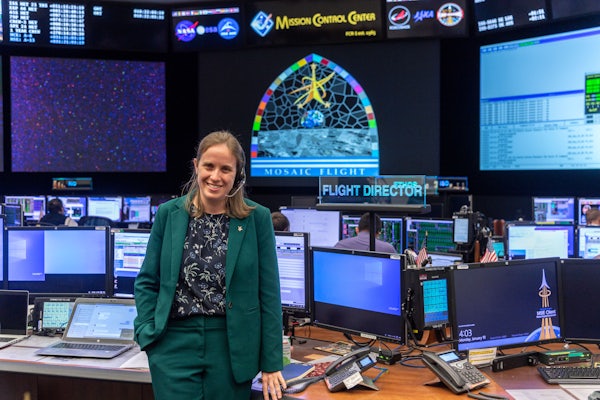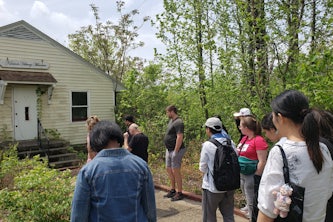Alumna Turett earns place in history as NASA’s 100th flight director
The 2009 alumna leads team of controllers of the International Space Station

Monday, Jan. 10, 2022, started out as a normal day for alumna Fiona Turett, but at 3:30 p.m., she made history when she took her seat at Mission Control at the Johnson Space Center in Houston as NASA’s 100th flight director since the position was established in 1960.
Turett, who earned a bachelor’s degree in mechanical engineering from the Engineering School in 2009, also is the 18th woman in the role, in which she will lead teams of flight controllers, engineers and professionals throughout NASA and the world, as well as supervise human spaceflight missions for the International Space Station and missions to the moon. It is a career milestone she has been preparing for since she was a teenager.
“It was awesome,” she said of her first day at Mission Control. “After finishing up a year of training and finally having my first shift in actual Mission Control with the actual Space Station with a crew on board, it was really cool,” she said. “It’s not the end of the road, and there is a lot more to learn and do, but it is a notable milestone, and it’s really exciting.”
When Turett started working at NASA full-time after earning a degree in three years from WashU, she had already completed three summer internships with NASA, her first between graduating from high school and her first semester of college, as well as a NASA Space Academy at age 13. She started at NASA in its Safety and Mission Assurance organization for the final nine space shuttle missions before moving to flight operations in 2012.
It seems a natural progression, then, for Turett to take her seat at Mission Control after a year of preparations in a class with three other new flight directors. She applied for the role in late 2020 after observing the influence and problem-solving abilities of existing flight directors over the past several years.
The first day as a flight director comes with a few traditions for each person, Turett said. She received a flight director’s pin and introduced her call sign — Mosaic — which she chose because it represented both her past and her future and to honor all of the pieces that make her whole. It also honors her parents, who are mathematicians. Her family was able to participate virtually in the first shift traditions.
On that shift, which began at 3:30 p.m., Turett and the team were planning for the next day while the crew on the space station slept. Their planning involves scheduling for the crew, including time for carrying out science experiments as well as maintenance on the space station, as well as looking for any potential problems or conflicts. It’s important that the crew make the best use of their time, she said.
“From the ground, we can control a lot of the robotics, including the robotic arm to move payloads around outside or do other various tasks outside,” she said. “We can change the station’s altitude or orientation from the ground and reconfigure the life support systems.”
Turett said the job involves a lot of responsibility.
“Deciding to apply for this role was a challenging decision because I knew the responsibility that it entailed, and it took some soul searching,” she said. “It’s humbling in a lot of ways — the trust that is put in us by the astronauts themselves, by their families and by the country as a whole. But we have a lot of resources to help us.”
As a student at WashU, Turett was a member of the Bandit/Akoya nanosatellite team under the supervision of her adviser, Michael A. Swartwout, who then was an assistant professor of mechanical, aerospace and structural engineering and is now at Saint Louis University.
“He handed ownership of the project over to students and gave us a lot of opportunity to learn and grow and to figure things out along the way,” she said.
Turett also praised other skills she learned while at WashU, including project management, presentation and technical writing.
“The technical writing class with Professor Ballard was fantastic,” she said. “It was so useful, and the further I get in my career, the more I’m glad I had that in college.”
Turett shares her advice with students who are interested in a career at NASA:
- Find ways to apply your knowledge outside of the classroom. It makes the academic learning more interesting and hands-on, and there are so many skills that a team project helps you to develop.
- Take advantage of NASA’s internship programs to get your foot in the door.
- Don’t get caught up in a 10-plus-year career plan. Think about it enough to do things that send you in the right direction.



